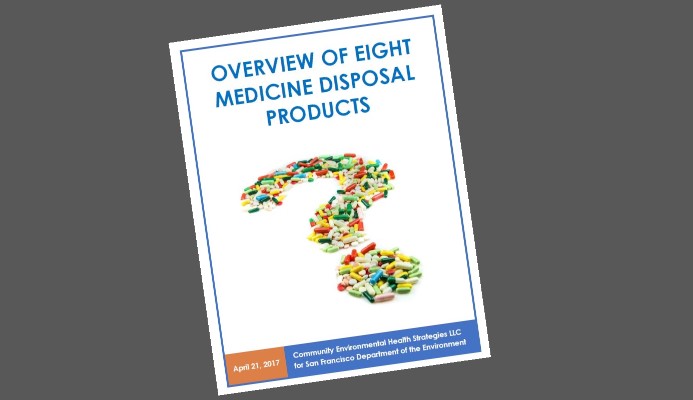New products in pouches and bottles are being marketed to consumers with claims that they provide a easy way to “denature” drugs and make them safe to toss in the household trash. Some companies have formed partnerships with elected officials to distribute free samples as part of educational campaigns. Other companies have formed partnerships with pharmacy chains who sell the products, or perhaps offer to provide them with a prescription.
What’s in these medicine disposal products? How do they work? Have they been tested for effectiveness? Are they safe? Are they worth the money?
Those questions have been circulating as various products have gone on and off the market in recent years. A San Francisco agency asked me to review available information on medicine disposal products being marketed to consumers as of early 2017: Deterra, DisposeRx, Drug Buster, Element MDS, Pill Catcher, Pill Terminator, and Rx Destroyer. I also looked at a related, but different, product – Cactus Smart Sink – that is designed for use in healthcare facilities.
After lots of reviewing and writing a detailed report, I still have more questions than answers.
Reviewing the manufacturers’ product information* reveals a number of concerns about the 7 medicine disposal products for consumer use:
- NOT approved by the DEA or the EPA or any federal agency. Federal agencies do not have any performance guidelines that apply to such products.
Claims by any manufacturer that their product meets or “passes” any federal standard are just the manufacturer’s opinion. Marketing of these products fails to mention that the DEA, the FDA, and other federal agencies recommend secure medicine take-back programs as better than trash disposal of medicines. - NOT proven to make drugs non-retrievable, inactive, or non-toxic.
No test results are provided for most of the products. Some of the manufacturers describe their own test results, not independently verified, but these tests are not convincing that medicines are destroyed or rendered harmless. Actually, some of the test data clearly shows that opioids and other drugs are NOT fully absorbed. Active drug compounds could be easily extracted from the product with water.
That’s not surprising given that the ingredients of most products appear to be designed to physically immobilize the chemicals rather than chemically degrade the drug. Examples of product ingredients, when disclosed include:- activated carbon for Deterra and Drug Buster
- clay for Pill Catcher
- “cross-linking polymers” for Dispose Rx
- “organic plant-based powder” for Element MDS.
- Costly for residents to use.
$6.99 for a pouch that holds 90 pills, for example. List prices of products ranged from $4 to $16 for units with capacity for 15 to 200 pills.
It’s unreasonable to think residents will pay such a cost on a regular basis. And hard to think that government agencies or pharmacies can afford to subsidize the cost of providing these products for the long-term. These medicine disposal products are tremendously more expensive, per pill or per pound, than secure drug take-back programs using drop boxes which are on the order of $2-$5 per pound, or return mailers which are $6 to $14 per pound. - Time-consuming and difficult to use, especially for large amounts of leftover or expired medicines.
The products only accept limited numbers of pills, when people often have a whole bag full after an illness or the loss of a family member. Several products state that foaming may occur during mixing with medicines. Some products have a vented bottle cap to release gas that is produced. Several of the products carry warning labels about potential skin or eye contact. - Not proven safe for trash disposal or environmentally friendly.
Some local jurisdictions prohibit disposal of waste pharmaceuticals in the household trash. Adequate testing has not been performed to demonstrate that the pharmaceutical-product mixtures are safe for solid waste disposal.
It seems a daunting task to design a disposal product that is safe to be used in the home and also capable of chemically degrading every type of pharmaceutical. The wide variety of chemicals used in medicines, the availability of medicines in multiple dosage forms, and the time required for medicines and the product to interact are all important considerations in the effectiveness of any medicine disposal product. Clearly, more rigorous and independent laboratory testing is needed to examine performance claims that drugs are rendered “non-retrievable” by a medicine disposal product.
Secure disposal of prescription opioids and other potentially addictive medicines is a critical part of a comprehensive approach to shutting down the “drug dealer” in our home medicine cabinets. In communities lacking secure drug drop boxes and without access to collection events or return mailers for medicine disposal, these products might serve a purpose. But is the cost worth it? Are they any better than the last resort method of mixing drugs with kitty litter as an attempt to hide them in the trash?
My full report is available from the Safe Medicine Disposal Policy & Resources page of the San Francisco Department of the Environment, see the section on In-Home Medicine Disposal Products Resources.
* My review of manufacturers’ product information is current as of March 2017. Information in the report was obtained from manufacturers’ websites, product materials, and product labels. I also reviewed patent information and available research literature.

Recent Comments